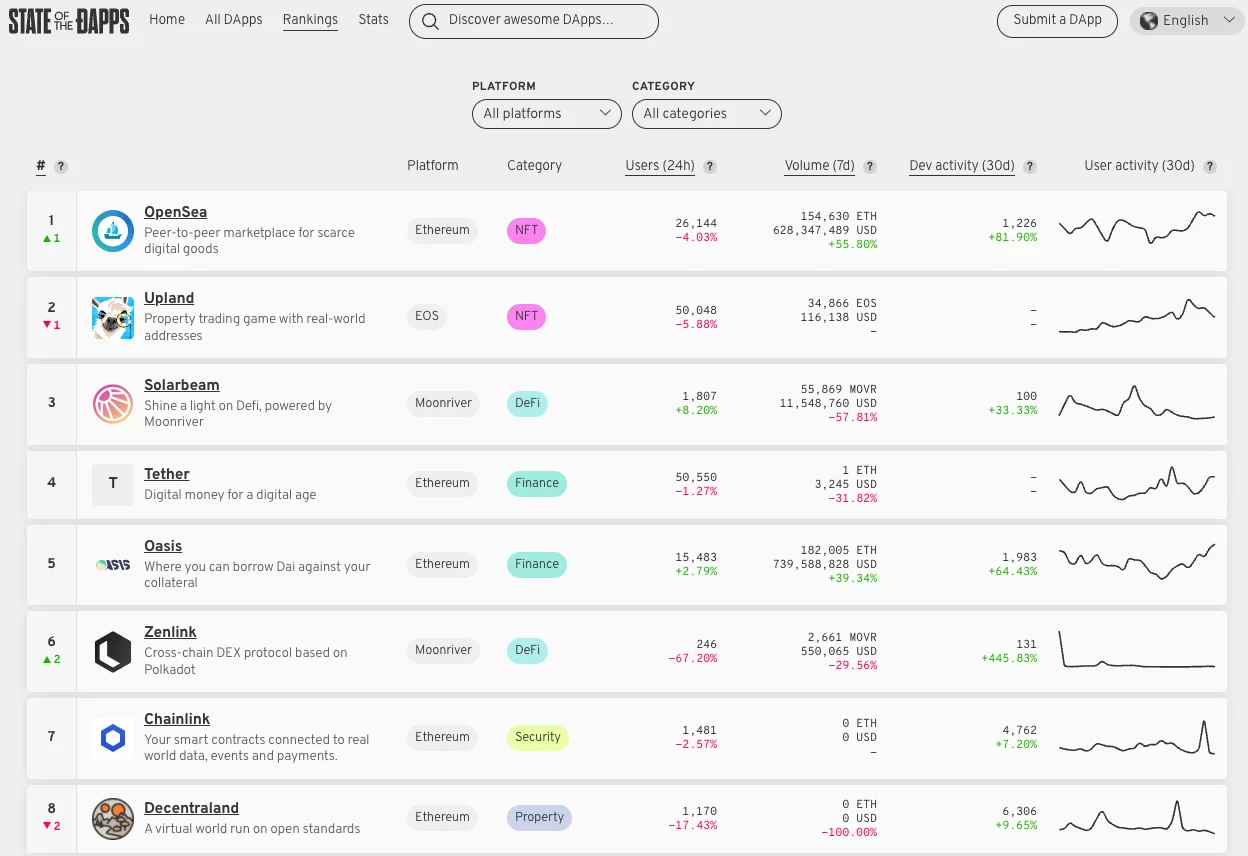The crypto market has grown from a research whitepaper in 2008 to a $2+ trillion asset class with over 15,000 coins traded across 440 exchanges.
Smart contracts and Dapps have been a major driving force behind the market’s tremendous growth. For instance, decentralized finance, or DeFi, applications have nearly $100 billion in total locked value. Meanwhile, more than $250 million worth of non-fungible tokens, or NFTs, are sold each week in the form of digital game items or collectibles.
Let's look at whether you should consider building blockchain applications, or Dapps, and some tips for getting started.
Blockchain applications, or dApps, provide integrity, reliability, and access to crypto tokens to incentivize users. Share on XWhat Are dApps?
A blockchain is simply a distributed ledger of immutable transactions. All network participants can freely access the ledger to verify transactions, but cryptography ensures that nobody can alter them. As a result, unlike centralized systems, there's no need to trust an intermediary to validate transactions or reconcile transactions.
Blockchain applications are known as Dapps, or decentralized applications. For example, CryptoKitties built one of the first Dapps on Ethereum's ERC-721 tokens, enabling users to breed and trade virtual cats. Since then, Dapps have been made to power everything from whimsical virtual games to complex financial services.
There are several reasons to consider building dApps:
- Integrity: The distributed nature of the blockchain means there’s no single point of failure, making it hard for anyone to take control of the network.
- Reliability: The distributed nature of the blockchain maximizes uptime because the network continues to operate even when individual nodes go down.
- Tokens: Blockchains provide access to flexible smart contracts and optionally integrate cryptocurrencies to provide incentives.
Of course, there are also some drawbacks:
- Security: The open-source nature of smart contracts on public blockchains provides hackers with opportunities to find vulnerabilities.
- Scalability: Some Dapps require network effects to be successful, meaning that low user counts can make them less valuable.
While Ethereum launched the idea of Dapps in 2013, the ecosystem has dramatically expanded in recent years. Some popular public blockchains include the Binance Smart Chain (BSC), TRON (TRON), Neo (NEO), SKALE (SKALE), and Polygon (MATIC). Many of these alternatives focus on delivering better performance and scalability.
In addition to these public blockchains, HyperLedger Fabric and other private blockchains enable enterprise developers to build non-public solutions. For instance, HyperLedger Grid provides reference implementations of supply chain-centric data types, data models, and smart contract-based business logic for logistics applications.
How to Build dApps
The first step in building a Dapp is coming up with an idea that could benefit from blockchain technology. If you're unsure where to start, State of dApps is a great way to explore possibilities by looking at more than 2,700 different dApps built on various platforms. You can quickly understand what use cases apply and how popular Dapps function.

State Of Dapps provides a comprehensive list of different Dapps and use cases. Source: State of Dapps
If you're building enterprise applications, you can explore private blockchain case studies on how the blockchain has helped transform the way specific industries operate. The HyperLedger Foundation's case studies provide several examples, such as how Tech Mahindra deployed the private blockchain to manage Abu Dhabi's Land Registry.
The next step is building a Dapp. As with conventional application development, there are many different ways to build dApps. You can outsource development to third parties, leverage easy-to-use developer tools, or start from scratch for maximum flexibility. The right decision depends on your application, time, budget, and other factors.
Truffle is the most popular and easy-to-use tool for developers to build public Dapps. Using JavaScript, you can make smart contracts that compile into Solidity and execute in Ganache, a personal blockchain for Ethereum development. There's even a front-end library called Drizzle that can make it easier than ever for React apps to incorporate Dapp capabilities.
Some other public Dapp frameworks to consider include:
- Hardhat: Hardhat is an Ethereum development environment for professionals that runs Solidity locally. The fully-extensible platform also has a budding plugin ecosystem and enables you to bring in your own tools to speed up development.
- Embark: Embark is an all-in-one developer platform to build, test, and deploy smart contracts. The platform takes care of the groundwork, watches for changes, and deploys the application when needed. There's also a debugger to help troubleshoot.
Enterprise developers will likely have to learn specific private blockchain protocols and languages. For instance, HyperLedger uses Chaincode to write smart contracts and build applications. The foundation provides training certifications to developers and administrators looking to develop robust enterprise applications using the tools.
The Bottom Line
Blockchain applications are becoming increasingly popular due to the success of DeFi and NFTs. That said, a growing number of enterprise companies are developing applications on private blockchains to better manage their supply chains and other internal processes without using centralized intermediaries or conventional databases.
If you’re interested in exploring blockchain applications, contact us to schedule a free consultation and learn how we can help you create a roadmap.



